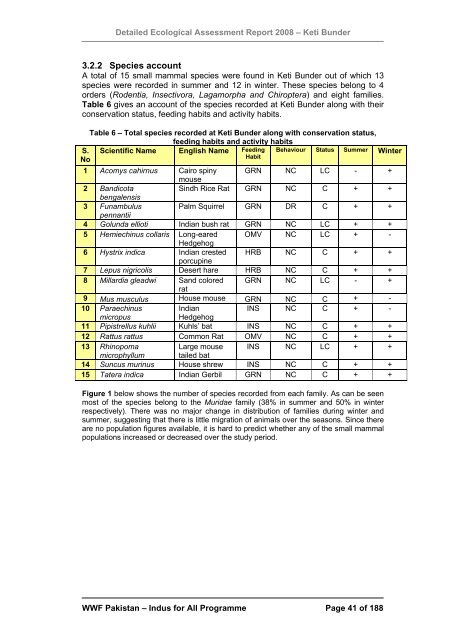Disclaimer note - WWF - Pakistan
Disclaimer note - WWF - Pakistan
Disclaimer note - WWF - Pakistan
You also want an ePaper? Increase the reach of your titles
YUMPU automatically turns print PDFs into web optimized ePapers that Google loves.
Detailed Ecological Assessment Report 2008 – Keti Bunder<br />
3.2.2 Species account<br />
A total of 15 small mammal species were found in Keti Bunder out of which 13<br />
species were recorded in summer and 12 in winter. These species belong to 4<br />
orders (Rodentia, Insectivora, Lagamorpha and Chiroptera) and eight families.<br />
Table 6 gives an account of the species recorded at Keti Bunder along with their<br />
conservation status, feeding habits and activity habits.<br />
Table 6 – Total species recorded at Keti Bunder along with conservation status,<br />
feeding habits and activity habits<br />
S.<br />
No<br />
Scientific Name English Name Feeding<br />
Habit<br />
1 Acomys cahirnus Cairo spiny<br />
mouse<br />
GRN NC LC - +<br />
2 Bandicota<br />
bengalensis<br />
Sindh Rice Rat GRN NC C + +<br />
3 Funambulus<br />
pennantii<br />
Palm Squirrel GRN DR C + +<br />
4 Golunda ellioti Indian bush rat GRN NC LC + +<br />
5 Hemiechinus collaris Long-eared<br />
Hedgehog<br />
OMV NC LC + -<br />
6 Hystrix indica Indian crested<br />
porcupine<br />
HRB NC C + +<br />
7 Lepus nigricolis Desert hare HRB NC C + +<br />
8 Millardia gleadwi Sand colored<br />
rat<br />
GRN NC LC - +<br />
9 Mus musculus House mouse GRN NC C + -<br />
10 Paraechinus Indian<br />
INS NC C + -<br />
micropus<br />
Hedgehog<br />
11 Pipistrellus kuhlii Kuhls’ bat INS NC C + +<br />
12 Rattus rattus Common Rat OMV NC C + +<br />
13 Rhinopoma<br />
Large mouse INS NC LC + +<br />
microphyllum tailed bat<br />
14 Suncus murinus House shrew INS NC C + +<br />
15 Tatera indica Indian Gerbil GRN NC C + +<br />
Behaviour Status Summer Winter<br />
Figure 1 below shows the number of species recorded from each family. As can be seen<br />
most of the species belong to the Muridae family (38% in summer and 50% in winter<br />
respectively). There was no major change in distribution of families during winter and<br />
summer, suggesting that there is little migration of animals over the seasons. Since there<br />
are no population figures available, it is hard to predict whether any of the small mammal<br />
populations increased or decreased over the study period.<br />
<strong>WWF</strong> <strong>Pakistan</strong> – Indus for All Programme Page 41 of 188

















